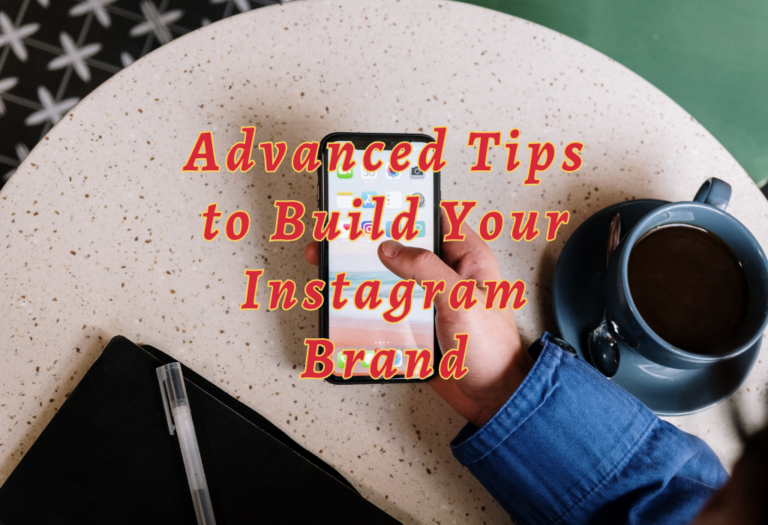11 Essential Branding Tips for Small Businesses: Stand Out in a Crowded Market
As a small business owner, you understand the importance of creating and managing your brand. But what are some effective branding tips that can help you stand out in an increasingly crowded market?
With so much competition, it’s important to focus on developing a strong visual identity, leveraging influencers and social media platforms, and ensuring quality content creation – all while keeping track of how customers perceive your brand. To build a successful brand for your small business venture, read our essential branding tips for small businesses below.

What is Branding?
Branding creates a unique identity for your business, setting it apart from competitors. It involves developing an image, logo, and message that conveys what makes your company special and why customers should choose you over others. A strong brand helps to create trust with potential customers, build loyalty among existing ones, and increase visibility in the marketplace.
Why is Branding Important for a Small Business?
Small businesses need strong branding just as much as larger companies do because it gives them credibility in their industry and makes them more memorable to potential customers. A well-crafted brand can help small businesses stand out from their competitors by:
Customers are more likely to purchase products or services from companies they know and trust than ones they don’t recognize or have never heard of. By creating a recognizable brand identity through visuals like logos and slogans, small businesses can build relationships with customers over time, leading to increased sales opportunities.
A strong brand communicates what matters most to your business—quality customer service or sustainability initiatives—and allows potential customers to quickly understand what makes you different from other companies in the same space.
Brands create emotional connections between themselves and their target audience by communicating messages that resonate emotionally rather than simply listing features or benefits of their product service offerings alone. For example, Nike’s “Just Do It” slogan has become synonymous with motivation, determination, perseverance, etc., making it easier for people to connect emotionally with its messaging.
Essential Tips for Branding a Small Business
In this post, we’ll go over some of the best marketing strategies for small businesses in terms of size and reputation.
So, let’s get started.
#1. Developing a Brand Identity
Creating a strong brand identity is essential for any business that wants to stand out from the competition and create an emotional connection with its customers. It involves creating a unique visual representation of your company and crafting messaging that resonates with your target audience. Here are some tips on how to develop an effective brand identity.
#2. Develop Your Brand Story and Mission Statement
Creating a brand story and mission statement is essential to building your business. According to a business dictionary, your mission statement should include these three points: define what is important to you, define your markets, and define the direction you intend to take the company.
Start by considering your brand personality. Your personality should be reflected in everything from company communications to product offerings – this will help set the tone and voice of your brand. Ask yourself: What do I want my customers to feel when interacting with my business? How can I make sure that message is consistent across all platforms?
Once you have a clear idea of who you are as a business, it’s time to craft a vision and mission statement. Your vision should describe what you hope to accomplish in the future, while your mission explains why you offer certain products or services – something that should remain true even as trends change over time. If crafting these statements feels overwhelming, try using a mission statement generator for guidance.
#3. Create a Visual Identity
Creating a solid visual identity is essential for any business. It’s the first thing potential customers will see, setting the tone for how they perceive your brand. Your logo, colors, fonts, and other visuals should all work together to create an overall look that reflects your company’s values and mission.
Create an SEO-friendly website
The first thing that any new business requires is a website where people can learn about it and purchase its products or services. You’ve already cleared the first hurdle if you create a website optimized for search engines and conversions.
Before investing in other marketing tactics, you should focus on increasing organic traffic to your website.
Design a logo
Start by designing a logo that captures the essence of your brand in one simple image. Think about what makes you unique and try to convey this message through your design. Choose colors that reflect your company’s identity – bold hues if you want to stand out or softer tones if you prefer subtlety. Then pick fonts that match the style of your logo – modern typefaces for contemporary brands or classic serifs for more traditional companies.
Use across all platforms
Once you have these elements in place, use them consistently across all platforms – from print materials like business cards and flyers to digital assets such as website graphics and social media posts. This helps build recognition with customers so they can easily identify with your brand wherever they encounter it online or offline.
Additional Visuals
You can also add additional visuals such as icons, illustrations, patterns, photos, videos etc., depending on what works best for each platform/medium (e-mail newsletters vs web banners). This help gives personality to your branding while making sure everything looks cohesive no matter where it appears online or offline.
Keep track
Finally, keep track of how people respond to each element of your visual identity so you can adjust accordingly over time based on customer feedback and analytics data collected from various sources (social media accounts/website traffic).
#3. Develop a Tagline
Developing a tagline is another way of ensuring people remember who you are quickly and easily; something short but memorable like “We Make Your Dreams Come True” works great here. This should be used consistently across all platforms so it becomes recognizable over time – think Nike’s “Just Do It” slogan.
When crafting a tagline:
Make sure the words are positive and inspiring rather than negative or limiting. For example, if you own an outdoor apparel store, instead of saying, “We sell outdoor gear”, try something like “Explore with us.” This communicates enthusiasm for adventure while conveying what kind of products you offer.
#4. Provide Legendary Customer Service
Treat your customers like royalty even if you are not in the service industry. The myth that customer service is only important in the service industry is debunked. All customers expect excellent service and will only tolerate short lines or satisfactory responses from representatives. Approximately 75% of customers state that customer service is a true indicator of a company’s competence.
#5. Utilize Social Media
Social media is an invaluable tool for businesses of all sizes. It can help you reach potential customers, build relationships with existing ones, and even create a brand identity. To make the most of social media, it’s important to understand how each platform works and what type of content resonates best with your target audience.
First, decide which platforms are right for your business. Popular options include Facebook, Twitter, Instagram, YouTube and LinkedIn, but many more are available depending on your industry or niche.
For example, email marketing makes money and you can expect an average ROI of $36 for every dollar spent on email marketing. That’s a better return than you’d get from any other type of marketing, digital or otherwise.
Once you have chosen the channels that will work best for you, create accounts on those platforms using consistent branding across all channels so that users recognize your company quickly when they visit any of them.
#6. Leverage Influencers
Influencer marketing is a powerful tool for businesses looking to increase their reach and visibility. By leveraging the influence of influential individuals, brands can build relationships with potential customers and create positive brand awareness.
Identifying influencers
The first step in leveraging influencers is identifying who they are. Influencers come from all walks of life, including celebrities, athletes, bloggers, YouTubers, Instagrammers and more. It’s important to find influencers that align with your brand values and target audience to ensure your message will resonate with them.
Start building relationships
Once you have identified the right influencers for your campaign, it’s time to build relationships with them. This involves engaging on social media by liking their posts or commenting on their content and sending direct messages introducing yourself and explaining why you think they would be a great fit for your campaign.
When it comes time to negotiate an agreement between both parties, make sure that everyone understands what is expected of each other before signing any contracts or agreements, and make sure the terms are clear regarding payment amounts (if applicable), post frequency/timing requirements and any different expectations that need to be met for the partnership to succeed.
Provide creative freedom
It’s also essential to provide influencers with creative freedom when creating content related to your brand – this helps ensure authenticity, which resonates better with followers than overly produced sponsored posts do. Additionally, providing helpful resources such as product images or talking points can help streamline the process while still allowing room for creativity from the influencer side too.
Monitoring results
Monitoring results throughout campaigns is essential to determine whether goals were achieved; this includes tracking impressions, engagements (likes/comments), and conversions. Doing so allows marketers to identify areas where improvements could be made in future campaigns – changing messaging strategies or finding new ways to engage audiences, etc.
#7. Focus on Quality Content
Quality content is essential for any successful brand. It’s the foundation of your online presence and how you communicate with customers, prospects, and influencers. Quality content helps build trust in your brand, establishes credibility, and drives engagement.
Understand what resonates with your target audience
Creating quality content starts with understanding what resonates with your target audience. Research their interests and preferences to determine the most relevant topics. This will help ensure that you create content that speaks directly to them—and keeps them coming back for more.
Start creating content
Once you have a better idea of what type of content resonates best with your target audience, it’s time to start creating it. Blog posts are one of the most popular types of quality content because they provide valuable information while being easy to read and digestible. In fact, by including 21-54 blogs on your website, you can increase traffic by 30%.
When writing blog posts, ensure they’re well-written and free from errors or typos; this will help establish trust in your brand as an authority on the topic. Additionally, consider adding visuals such as images or videos throughout the post; these can help break up long blocks of text while providing additional context about the topic being discussed.
In addition to blog posts, other forms of quality content include videos (e.g., tutorials), podcasts (e.g., interviews), infographics (e.g., data visualizations), and ebooks (e.g., how-to guides). Videos can provide step-by-step instructions or demonstrate a product in action, while podcasts give an in-depth look at a topic from an expert’s perspective. Infographics are useful for quickly conveying complex information in an easy-to-understand format, and ebooks offer comprehensive overviews of specific issues that readers can refer back to as needed.
#8. Find a Voice for Your Brand
Your brand voice is an integral part of your business. It’s the way you communicate with customers, partners, and employees. It’s how you express yourself in all aspects of your branding—from website copy to social media posts to email campaigns.
Understanding Your Brand Voice
Before creating a successful brand voice, it’s important to understand what it means for your company. A strong brand voice should reflect the values and personality of your business while resonating with its target audience. Take some time to consider who you are as a company and who you want to reach before developing a unique tone that will help set you apart from competitors.
Choosing Your Tone
Once you understand what makes up your brand identity, it’s time to decide on the right tone for communicating with customers and other stakeholders. Consider whether formal or informal language works best for representing your message; if humor is appropriate; if any industry-specific terms need to be incorporated into communications; etc.
Creating Consistency
It’s essential that once established, the same consistent messaging is used across all channels – from website content through customer service interactions – so that customers recognize the same style wherever they encounter it. This helps build trust between them and their chosen brands, leading directly to increased sales figures over time and improved loyalty levels amongst existing clients and customers alike.
#9. Never Take a Break From Building Your Brand
It’s important to remember that building a brand is an ongoing process. You can’t just set it and forget it; you must constantly evaluate, tweak, and adjust your strategy to stay ahead of the competition. Here are some tips for keeping your brand fresh:
Stay Relevant
The world changes quickly, so ensure your brand keeps up with the times. Stay abreast of current trends in fashion and technology so that you stay caught up and become relevant in today’s ever-evolving landscape.
Be Consistent
Consistency is key in building a strong brand identity—you want people to recognize and associate certain elements (like colors or fonts) with your company immediately upon seeing them.
Adapt To Change
Change isn’t always easy, but sometimes it’s necessary to keep up with the times or remain competitive within an industry—especially if there has been significant growth or disruption within the said industry since its inception (think Uber).
Feel free to shake things up by updating logos, slogans, packaging designs etc., as long as these changes still reflect the core values of what makes your company unique.
#10. Monitor Your Brand Reputation
It’s essential to monitor how people perceive your brand online. This can be done by tracking reviews on social media sites like Yelp or Google My Business and promptly responding to customer inquiries.
Tracking reviews
By keeping an eye on customer comments and feedback, you can identify areas of improvement for your business and address any issues that may arise quickly. It also allows you to create a positive relationship with customers and build trust in your brand.
Track mentions of specific keywords
It would help if you also took advantage of tools such as Google Alerts, which allow you to track mentions of specific keywords related to your business across the web so that you can stay informed about what is being said about it online at all times. This will help ensure that the negative press is noticed and addressed.
Engaging with influencers
Engaging with influencers with large followings on social media platforms is another great way to monitor how people talk about your brand online. Influencers often have more influence over their followers than traditional advertising methods, making them invaluable when building awareness around new products or services offered by businesses they endorse or promote through sponsored content campaigns.
FAQs About Branding Tips for Small Businesses
Conclusion
In conclusion, branding tips for small businesses are essential to success. Understanding your brand and creating a visual identity will help you stand out from the competition.
Developing a tagline, utilizing social media, leveraging influencers and focusing on quality content can all help build your brand’s reputation.
Finally, monitoring your brand reputation is key to avoiding any potential issues that may arise. With these branding tips for small businesses in mind, you’ll be well on your way to building an effective and successful business.






